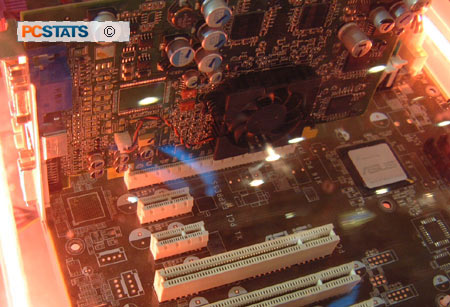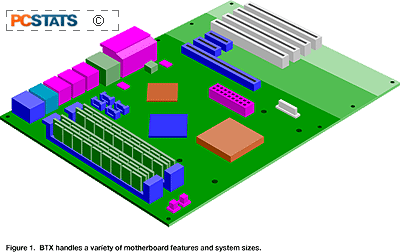As
mentioned previously, the PCI Express bus is software compatible with PCI 2.2 compliant
devices. As Intel stated, all current operating systems will support PCI
2.2 compatible interface cards in PCI Express systems using the existing
PCI drivers. This is because the legacy bus is still present, just in a reduced
form.
This was an essential requirement if PCI Express technology was to gain widespread acceptance. Forced obsolescence
does not tend to go over well with computer users.
PCI
Express chipsets and connectors 
The current standard PCI Express
implementation, as seen in chipsets from Intel, nVidia and VIA, allows for
20 lanes of PCI Express in total. 16 of these are used for the PCIe x16
graphics slot and four more are distributed between any combination of PCIe x1,
x2 or x4 slots.
Current PCI Express capable chipsets include
Intel's 915, 925 and upcoming 955, nVidia's Nforce 4 and nForce 4 SLI Intel
Edition and VIA's K8T890, among others. Both AMD and Intel processors are
now well-supported with PCI Express, though Intel chips had the technology well
before AMD chips realized it with the introduction of the nForce 4.
Other than video cards, there
are few PCI Express-based peripherals on the market, but with nVidia
and ATI's products spearheading a huge adoption of PCI Express capable
motherboards, it should not be long until peripherals based on the
technology are currently available.

It was predicted that Gigabit Ethernet adaptors would be
the first technology to be commonly available using PCI Express besides video
cards, but since most PCI Express capable motherboards now integrate Gigabit adaptors, there is little
demand for them in the desktop market.
A PCI Express 1X connector is ideal for
gigabit Ethernet cards, which have enough throughput to potentially cripple a
standard PCI 2.2 bus. As found in most modern PCI Express
motherboards, the Gigabit Ethernet controller is soldered directly to the
motherboard and runs through the PCIe bus.
The BTX
form factor (announced at IDF 2003) is intended as the replacement for
the current ATX motherboard standard, and included in its specifications are an
X16 slot instead of an AGP connector for graphics, and two 1X PCI Express
connectors in place of several of the PCI slots.
In the
picture to the left, the PCI Express slots are coloured blue. The BTX formfactor
is beyond the scope of this article, so for more information about it, look
here.
